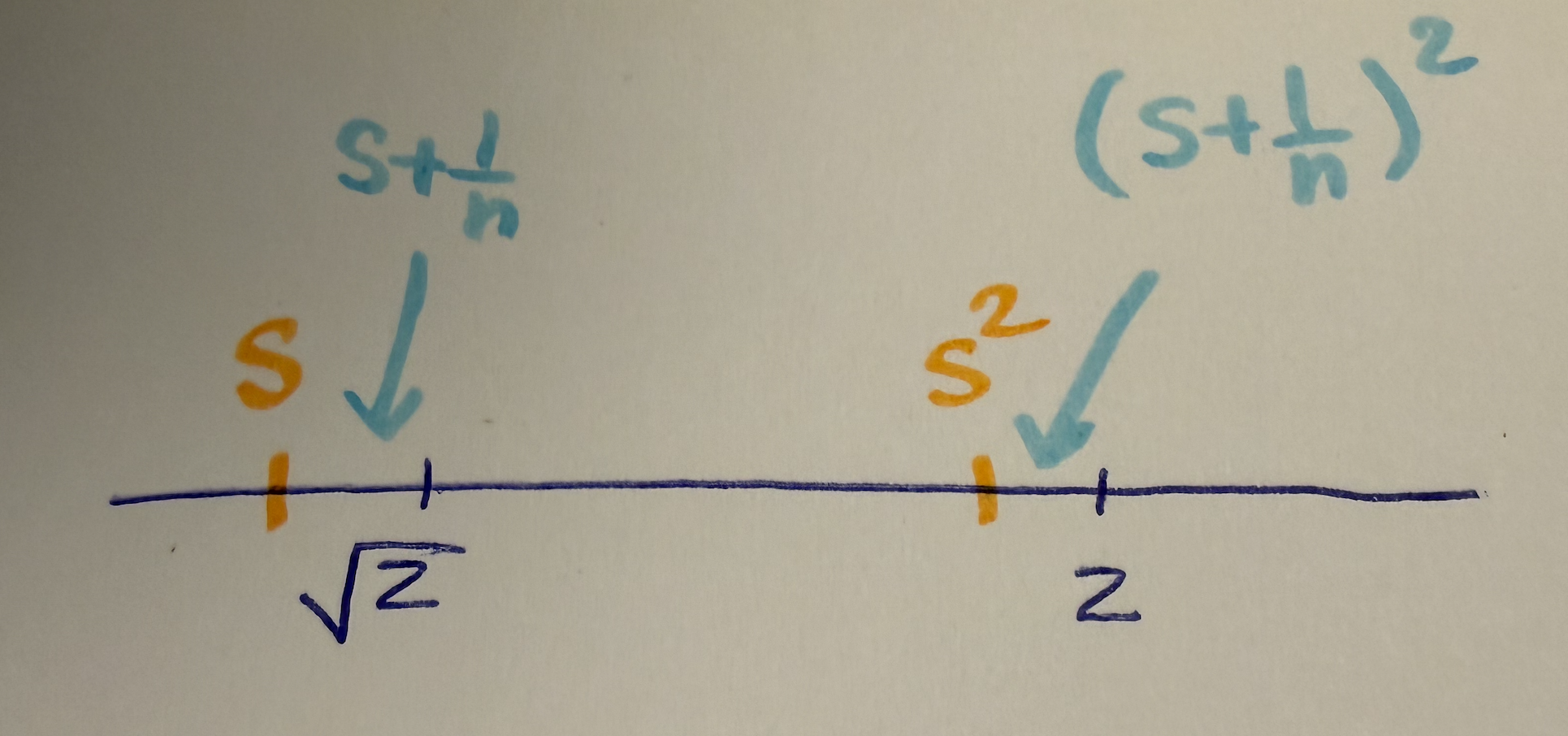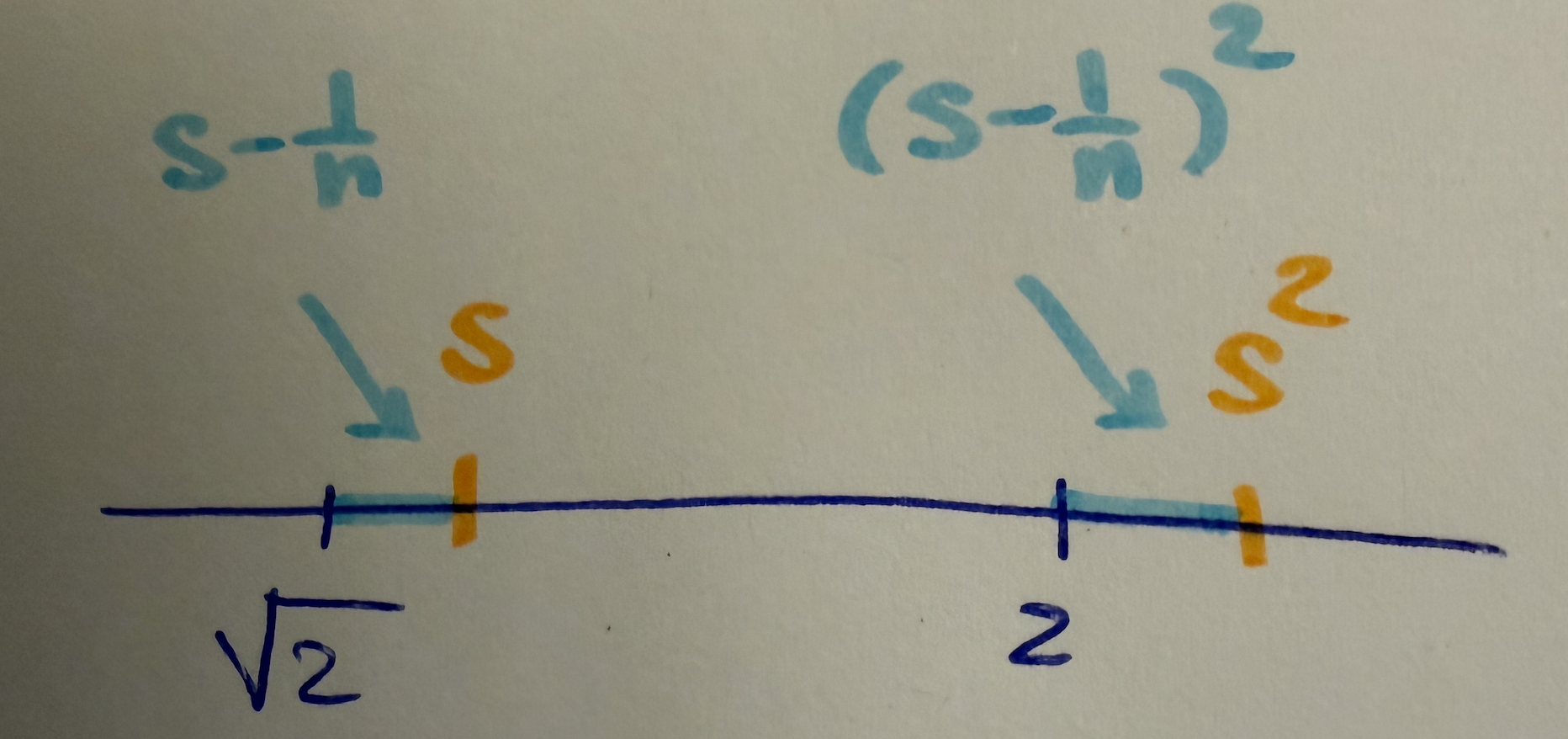Strategy
Let \(E = \{x \in \mathbb{R}^{+} \mid x^2 < 2\}\) and let \(s = \sup(E)\). We want to show that \(s^2 = 2\). This will mean that that the supremum itself is the “Square root of \(2\)”. We do this by showing that it’s impossible for \(s^2\) be greater than \(2\) or less than \(2\) so it must be \(2\). Then, we have two cases.
Case 1: \(s^2 < 2\): Here, we want to show that it’s impossible to have \(s^2 < 2\). Why? because \(s\) is now going to be too small to be the square root of \(2\) or the supremum. This is because we will be able to find a number slightly larger than \(s\) and have its square be less than \(2\) still which means it’s in the set. This is a contradiction since now \(s\) is no longer the supremum.

To show this:
- We can pick a number that is slightly bigger than \(s\). Let this number be \(s + \frac{1}{n}\).
- When we square this number, then \((s+\frac{1}{n})^2\) is still going to be under \(2\).
- This means that \(s+\frac{1}{n}\) belongs in the set \(E\). This is a contradiction since we said that \(s\) is the supremum.
So we can go back to point \(2\) and derive what \(n\) should be
What do we do with \(\frac{1}{n^2}\)? The goal is to show that \(\left(s+\frac{1}{n}\right)^2\) is less than \(2\). So if we show that a bigger fraction is less than \(2\), then automatically, \(\left(s+\frac{1}{n}\right)^2\) is less than \(2\). So the idea here is to replace \(\frac{1}{n^2}\) with a bigger number to make it simpler. So let’s replace it with \(\frac{1}{n}\). Notice how \(\frac{1}{n} > \frac{1}{n^2}\). So this makes the new fraction bigger.
So now if we choose this \(n\) (using the Archimedean principle), then we will guarantee this fraction to be less than \(2\) which is what we want.
Case 2: For case 2, we have \(s^2 > 2\) and this picture

We want to show that if \(s^2 > 2\), then we will be able to pick a slightly smaller \(s\) and we will show that this smaller \(s\) is actually an upper bound on \(E\). But it’s smaller and it’s an upper bound, then \(s\) is not a supremum so that’s a contradiction and \(s^2 \not> 2\). To derive this \(n\), then
We want to show that this quantity is greater than \(2\). So here it’s the opposite. To ensure it’s greater than \(2\), we want a weaker simpler quantity (not a bigger one). So notice now that if we remove \(\frac{1}{n^2}\), then this quantity will be smaller.
and what we want is this to have this smaller quantity to be larger than \(2\). In particular we want
We can now again use the Archimedean property to get that \(n\).
To recap, in case \(1\) where \(s^2 < 2\). Here, we will find an element in the set that’s greater than \(s\) which is a contradiction. In case \(2\), \(s^2 > 2\), we will be able to find a better bound than \(s\) itself so \(s\) can no longer be a supremum.
Proof
Let \(E = \{x \in \mathbb{R}^{+} \mid x^2 < 2\}\) and let \(s = \sup(E)\). We want to show that \(s^2 = 2\). Suppose for the sake of contradiction that \(s^2 \neq 2\). We have two cases.
Case 1: \(s^2 < 2\). Then we know that \(2 - s^2 > 0\). Therefore \(\frac{2s + 1}{2 - s^2} > 0\). Thus, by the Archimedean principle, we can pick \(n\) such that
This implies that
Observe now that
This shows that \(\left(s+\frac{1}{2}\right)^2 < 2\). So \(s+\frac{1}{n} \in E\). This is a contradiction since \(s\) is the supremum of the set by assumption. Therefore, \(s^2 \not< 2\).
Case 2: \(s^2 > 2\). Then we know that \(s^2 - 2 > 0\) and so \(\frac{2s}{s^2 - 2} > 0\). By the Archimedean principle, choose \(n\) such that
This implies that
Now, observe that
This shows that \(s - \frac{1}{n}\) is an upper bound on \(E\). This is a contradiction since \(s\) is the supremum of \(E\). Therefore, \(s^2 \not<2\). Thus, by case 1 and case 2, we must have \(s^2 = 2\). \(\ \blacksquare\)
References
- Lecture Notes by Professor Chun Kit Lai